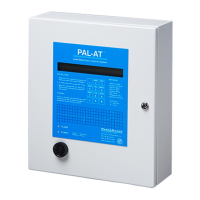PAL-AT Operating Manual
37
3.3 Leak Analysis
The procedure to locate a leak depends on whether the leak is at an accessible location or inaccessible
location. Menu function 2, History of Events, is used during the analysis to determine where a leak exists.
Step through the history archive and record the appropriate data (time, distance and map number) for
entries referring to a leak and new reference map. Do this for all entries made since the first alarm was
recorded in the same general area as the present leak.
3.3.1 Accessible Applications - Raised Floor systems
Refer to the system layout drawing and inspect the location of the leak. The high airflow beneath the
raised floor can evaporate some, or all, of the leak before the area is inspected. This may make it hard to
find the source of the leak.
Sometimes cables are moved after commissioning and the drawings are not documented with the
changes. If you cannot find the wet area, disconnect the closest connector to the leak distance to create
a break in the cable. Note the distance to the break on PAL-AT and compare it with the leak distance. In
this manner, you can get in the general area of the leak and then measure off the distance to the actual
location for closer inspection.
If AGT-Gold sensor cable is located in the direct airflow of air handlers, there may be intermittent
leak/drying alarms as moisture or a fine mist in the airflow is absorbed by the cable and later evaporated.
The problem may be eliminated by shielding the cable from direct airflow or relocating it slightly out of the
direct air path. Another option is to substitute AGW-Gold in that area to eliminate the problem. AGW-Gold
does not absorb a mist and dries quickly.
If there are multiple alarms in a general area, note the times of the alarms. Is there a pattern of a particular
time of day the alarms occur? Does it coincide with changes in the sensor cable environment? For
example, if the temperature of the floor in a monitored area is lowered at night to below the dew point,
condensation can occur. When the temperature is raised during the day, the water evaporates and the
leak cannot be found.
3.3.2 Inaccessible Applications – Contained Piping Systems
Once PAL-AT locates a “Leak”, refer to the layout drawing of the leak detection system. It is important to
determine if there is a true leak or a puddle. Typically, leaks get larger, puddles do not. A puddle may be
condensation from moisture that entered the containment system during installation. Condensation
puddles, as with all leaks, should be dried to prevent damage to the pipe and leak detection system.
Typically, low points and drainage slopes are shown on the drawing. Compare the location of the leak on
the PAL-AT display with the system drawing and find the physical location of the leak. Once the slope is
determined, the data can be analyzed.
If a leak is found several times in the same general location, it is a reasonable assessment that there is an
actual leak and not just condensation. The first “leak” entry in the history, at the same general distance,
shows the location where the leak was first detected. If the system slopes away from PAL-AT at the leak,
the pattern of archive records shows a series of leaks at the same spot in the system. If the system slopes
toward PAL-AT, the pattern shows the leaks getting closer. PAL-AT records the distance to the closest
point of the fluid in the sensor string.
Isolate the cause of the alarm. An air test of the secondary containment or a pressure test of the product
pipe helps determine if the containment is intact or if the product pipe is leaking.
3.3.3 Direct Buried Applications
When direct-buried TFH or TFH-Gold cable is contaminated with a hydrocarbon liquid or a surfactant like
soap, it must be replaced. The contamination destroys the water repellency properties of the cable and
water can enter the cable. If the cable is installed in slotted PVC pipe, the slotted pipe must be flushed to
remove all hydrocarbon residue before replacing the cable or the new cable will be contaminated. Any
contaminated soil must also be replaced.
If buried TFH/TFH-Gold is submerged in water or saturated soil and the water freezes, the resulting
compression of the cable may be detected as a leak and cause an alarm. It does not damage the cable.
The system will treat it as a leak, create a new map and continue to monitor for additional changes. When
the water or frozen soil thaws, the system will detect drying and go back to the original map.

